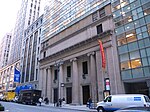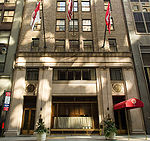New York City, the most populous city in the United States, is home to more than 7,000 completed high-rise buildings of at least 115 feet (35 m), of which at least 102 are taller than 650 feet (198 m). The tallest building in New York is One World Trade Center, which rises 1,776 feet (541 m). The 104-story skyscraper also stands as the tallest building in the United States, the tallest building in the Western Hemisphere, and the seventh-tallest building in the world. At 1,550 feet (472 m), Central Park Tower is the second-tallest completed building in the city. It has the highest roof of any building outside Asia, and is the tallest residential building in the world. The third-tallest completed building in the city is 111 West 57th Street. Rising to 1,428 feet (435 m), it is the world's most slender skyscraper. The fourth-tallest is One Vanderbilt. At 1,401 feet (427 m), it is the tallest office building in Midtown. The fifth-tallest is 432 Park Avenue at 1,397 feet (426 m).
At 1,250 feet (381 m), the 102-story Empire State Building in Midtown Manhattan, which was finished in 1931, stood as the tallest building in the world from its completion until 1970, when construction on the 1,368-foot (417 m) North Tower of the original World Trade Center surpassed it. It is the tenth-tallest building in the United States, and rises to a pinnacle of 1,454 feet (443 m) including its antenna. The North Tower (the original One World Trade Center), along with its twin the South Tower (the first Two World Trade Center), which was six feet shorter, held this title only briefly as they were both surpassed by construction of the 110-story Willis Tower in Chicago in 1973. The Twin Towers remained the tallest buildings in New York City until they were destroyed in 2001 during the September 11 attacks, leaving the Empire State Building again as the city's tallest building.
The new One World Trade Center began construction in 2006; in April 2012 it surpassed the Empire State Building to become the city's tallest. Upon its topping out in May 2013, the 1,776-foot (541 m) One World Trade Center surpassed the Willis Tower to become the tallest building in the United States and the Western Hemisphere. One World Trade Center is part of the redevelopment of the World Trade Center, which also includes the 1,079-foot (329 m) 3 World Trade Center, the 977-foot (298 m) 4 World Trade Center, the 743-foot (226 m) 7 World Trade Center, the approved 900-foot (274 m) 5 World Trade Center, and one partly constructed on-hold building: the 1,350-foot (411 m) 2 World Trade Center.
The majority of skyscrapers in New York City are concentrated in Midtown and Downtown Manhattan, although other neighborhoods of Manhattan and the boroughs of Brooklyn, Queens, and the Bronx also contain some high-rises.
As of March 2024, there were 317 completed skyscrapers that rose at least 492 feet (150 m) in height, more than any other city in the Western Hemisphere, and third most in the world exceeded only by Hong Kong and Shenzhen.









